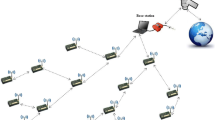Abstract
In Wireless Sensor Networks (WSNs), it is necessary to predict computational overheads of security mechanisms without final implementations to provide guidelines for system design. This paper presents an accurate and flexible model to predict overheads of these mechanisms. This model is based on overheads of basic operations frequently used in cryptography algorithms, which are essential elements of security mechanisms. Several popular cryptography algorithms and security mechanisms are evaluated using this model. According to simulation results, relative prediction errors are less than 7% for most cryptography algorithms and security mechanisms.
Similar content being viewed by others
References
A. Perrig, J. Stankovic, and D. Wagner. Security in wireless sensor networks. Communications of the ACM, 47(2004)6, 53–57.
E. Shi and A. Perrig. Designing secure sensor networks. IEEE Wireless Communications Magazine, 11(2004)6, 38–43.
A. Perrig, R. Szewczyk, V. Wen, et al. SPINS: security protocols for sensor networks. The 7th Annual International Conference on Mobile Computing and Networking, Rome, Italy, July 16–21, 2001, 189–199.
C. Karlof, N. Sastry, and D. Wagner. Tinysec: A link layer security architecture for wireless sensor networks. The 2nd International Conference on Embedded Networked Sensor Systems, Baltimore, Maryland, USA, Nov. 3–5, 2004, 162–175.
M. Passing and F. Dressler. Experimental performance evaluation of cryptographic algorithms on sensor nodes. The 3rd IEEE International Conference on Mobile Ad-hoc and Sensor Systems, Vancouver, Canada, Oct. 9–12, 2006, 882–887.
N. Fournel, M. Minier, and S. Ubeda. Survey and benchmark of stream ciphers for wireless sensor networks. The 1st Workshop in Information Security Theory and Practices, Heraklion, Greece, May 8–11, 2007, 202–214.
W. Liu, R. Luo, and H. Yang. Cryptography overhead evaluation and analysis for wireless sensor networks. The International Conference on Communications and Mobile Computing, Kunming, Yunnan, China, Jan. 6–8, 2009, 496–501.
P. Ganesan, R. Venugopalan, P. Peddabachagari, et al. Analyzing and modeling encryption overhead for sensor network nodes. The 2nd International Workshop on Wireless Sensor Networks and Applications, San Diego, CA, USA, Sep 19, 2003, 151–159.
Y. W. Law, J. Doumen, and P. Hartel. Survey and benchmark of block ciphers for wireless sensor networks. ACM Transactions on Sensor Networks, 2(2006)1, 65–93.
G. Boato, F. Granelli, and E. Tecchio. A methodology for numerical evaluation of the computational complexity of AES and Camellia. The 9th International Conference on Distributed Multimedia Systems, Miami, Florida, USA, Sep. 24–26, 2003, 628–631.
R. L. Rivest. The RC5 encryption algorithm. The 2nd International Workshop on Fast Software Encryption, Leuven, Belgium, Dec. 14–16, 1994, 86–96.
B. Schneier. Applied Cryptography. 2ed, New York, John Wiley & Sons, 1996, Chs. 9 and 17.
D. Wheeler and R. Needham. TEA, a tiny encryption algorithm. The 2nd International Workshop on Fast Software Encryption, Leuven, Belgium, Dec. 14–16, 1994, 363–366.
Crossbow Inc. MicaZ Data Sheet. http://www.xbow.com. May 2009.
B. L. Titzer, D. K. Lee, and J. Palsberg. Avrora: scalable sensor network simulation with precise timing. The 4th International Symposium on Information Processing in Sensor Networks, Los Angeles, CA, USA, Apr. 25–27, 2005, 477–482.
Author information
Authors and Affiliations
Corresponding author
Additional information
Supported by 863 Project of China (No.2006AA01Z224).
Communication author: Luo Rong, born in 1970, female, Associate Professor.
About this article
Cite this article
Liu, W., Luo, R. & Yang, H. An accurate prediction model for computational overheads of security mechanisms in Wireless Sensor Networks. J. Electron.(China) 26, 699–705 (2009). https://doi.org/10.1007/s11767-009-0052-0
Received:
Revised:
Published:
Issue Date:
DOI: https://doi.org/10.1007/s11767-009-0052-0




